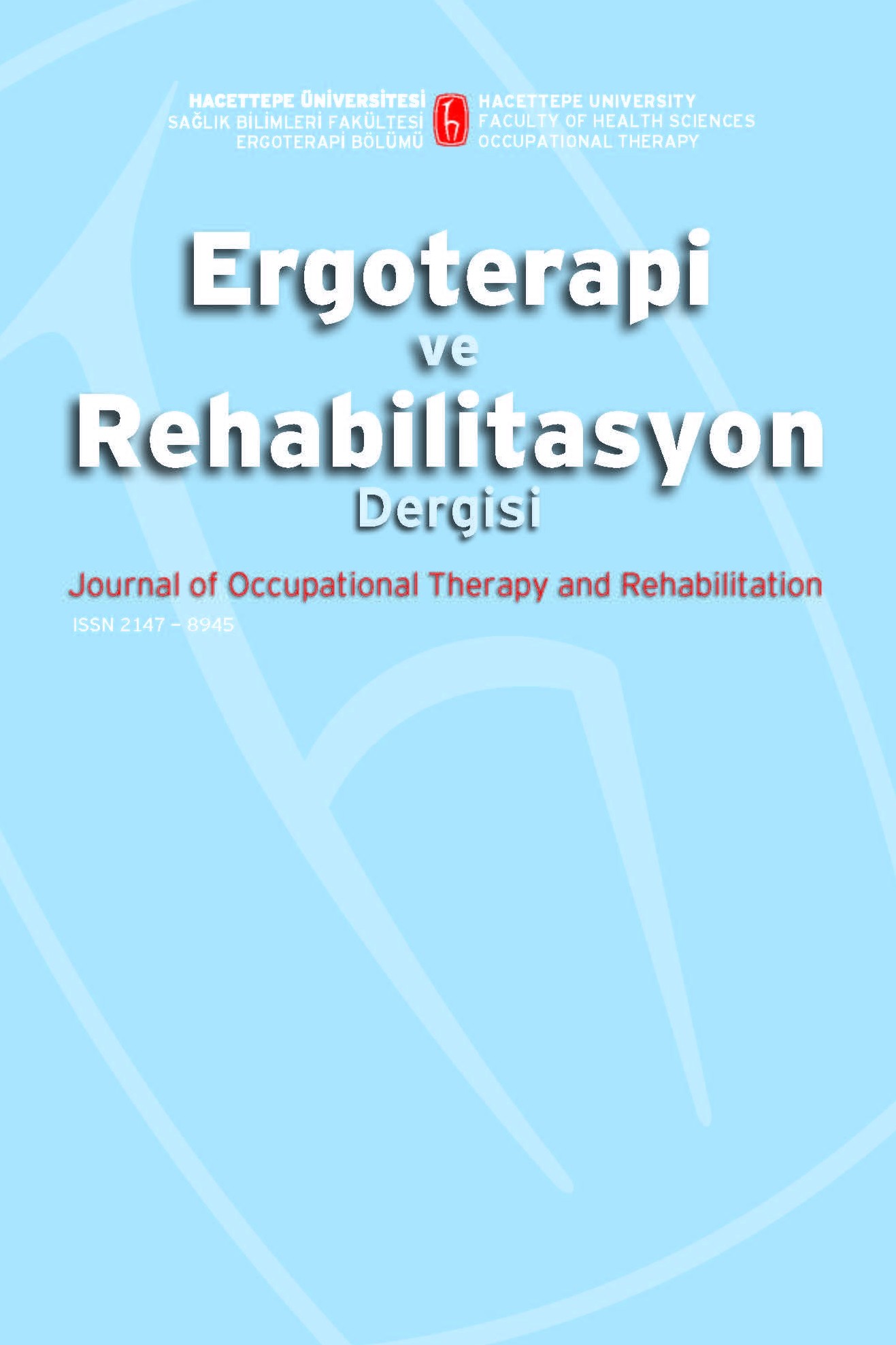Effect of Dental Braille Education (Dbe) on Oral Health Knowledge and Attitudes on Children with Visual Impairment
Oral health, Visually impaired persons
Görme Engelli Çocuklarda Dental Braille Eğitiminin Ağız Sağlığı ve Tutumları Üzerindeki Etkileri
Ağız sağlığı, Görme özürlü bireyler,
___
- Agnintia, D., Rachmawati, F., Arsita, R., & Berti, P. L. (2014). ‘Qualİty Self Care and Home Care’ Solusi Kesehatan Gigi Dan Mulut Anak Tunanetra Di Sdlb
- A-Ykab Surakarta. Program Kreativitas Mahasiswa- Pengabdian Kepada Masyarakat.
- Broadbent, J. M., Thomson, W. M., Boyens, J. V., & Poulton, R. (2011). Dental plaque and oral health during the first 32 years of life. J Am Dent Assoc, 142(4), 415-426.
- Maher, C. A., Lewis, L. K., Ferrar, K., Marshall, S., De Bourdeaudhuij, I., & Vandelanotte, C. (2014). Are health behavior change interventions that use online social networks effective? A systematic review. J Med Internet Res, 16(2), e40.
- Kadkhoda, Z., Rezaei, A., & Amiri, A. (2014). Effect of visual impairment education on the improvement of oral hygiene and reduction of periodontitis prevalence. International Journal of Medical Dentistry, 4(2), 7.
- Bina, D. B. K. A. D., Gizi, I. K. K. D. B., & Anak, K. I. (2011). Pedoman pelayanan kesehatan anak di Sekolah Luar Biasa (SLB): bagi petugas kesehatan-[BUKU].
- Perempuan, K. P. (2013). Panduan Penanganan Anak Berkebutuhan Khusus Bagi Pendamping (Orang Tua, Keluarga, dan Masyarakat).
- Kumar, R. V., Fareed, N., & Shanthi, M. (2013). The effectiveness of oral health education program with and without involving self-maintainable oral hygiene skills among the visually impaired children. Int J Sci Study, 1, 51-9.
- Neuman, L. W. (2002). Social research methods: Qualitative and quantitative approaches.
- Notoatmodjo, S. (2002). Metodologi Penelitian Kesehatan Jakarta: Rineka Cipta..(2007). Promosi kesehatan teori dan ilmu perilaku. Jakarta: Rineka Cipta.
- Putri, M. H., & Sirait, T. (2014). Pengaruh Pendidikan Penyikatan Gigi dengan Menggunakan Model Rahang Dibandingkan dengan Metode Pendampingan terhadap Tingkat Kebersihan Gigi dan Mulut Siswasiswi Tunanetra SLB-A Bandung. Majalah Kedokteran Bandung, 46(3), 134-142.
- Raiyani, C. M., Arora, R., Deepak P.B., & Dogra. S. (2014). Evaluation of efficacy of various types of toothbrush grips used to remove dental plaque by visually impaired children . Scholars Acad J Biosci, 2(11), 742–45.
- Ravishankar, P. L., Jayapalan, C. S., Gondhalekar, R. V., Krishna, B. J., Shaloob, K. M., & Ummer, P. F. (2013). Prevalence of dental caries and oral hygiene status among school going children: an epidemiological study. J Contemp Dent Pract, 14(4), 743- 746.
- Reddy, V. K., Chaurasia, K., Bhambal, A., Moon, N., & Reddy, E. K. (2013). A comparison of oral hygiene status and dental caries experience among institutionalized visually impaired and hearing impaired children of age between 7 and 17 years in central India. J Indian Soc Pedod Prev Dent, 31(3), 141.
- Sabilillah, M.F., Taftazani, R.Z., Sopianah, Y., Fatmasari, D., 2016. Pengaruh Dental Braille Education (DBE) terhadap Oral Hygiene pada Anak Tunanetra. Tasikmalaya.
- Sheehy, N et al., 2004. Volume 59 Number 5 May 2004. American Foundation for the Blind, 59(5), 1–27.
- Singh, A., Kumar, A., Berwal, V., & Kaur, M. (2014). Comparative study of oral hygiene status in blind and deaf children of Rajasthan. Adv Med Dent Sci, 2, 26-31.
- Zeng, X. T., Leng, W. D., Zhang, C., Liu, J., Cao, S. Y., & Huang, W. (2015). Meta-analysis on the association between toothbrushing and head and neck cancer. Oral Oncol, 51(5), 446-451. i/S1368837515001268.
- ISSN: 2147-8945
- Yayın Aralığı: 3
- Başlangıç: 2013
- Yayıncı: Hacettepe Üniversitesi Sağlık Bilimleri Fakültesi
Dilşad AKAL, Mustafa Necmi İLHAN
Reieza Zulfahmi TAFTAZANİ, Muhammad Fiqih SABİLİLLAH, Tetet KARTİLAH, Cahyo NUGROHO, Hadiyat MİKO
Görme Engelli çocuklarda Dental Braille Eğitiminin Ağız Sağlığı ve Tutumları Üzerindeki Etkileri
Hadiyat MİKO, Cahyo NUGROHO, Tetet KARTİLAH1, Muhammad Fiqih SABİLİLLAH1, Reieza Zulfahmi TAFTAZANİ
Meme Kanseri Etiyolojisi ve Risk Faktörleri
Aylin AÇIKGÖZ, Emine AKAL YILDIZ
Görsel Geri Bildirimin Postür Üzerine Etkisinin Araştırılması
İşitme Engellilere Yönelik İşaret Diliyle Bel Okulu Eğitiminin Oluşturulması
İlkem Ceren E-mail: İlkemceren24@gmail.com SIĞIRTMAÇ, Esra ALAN
